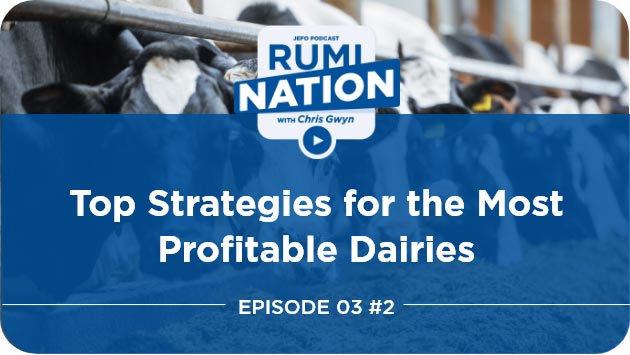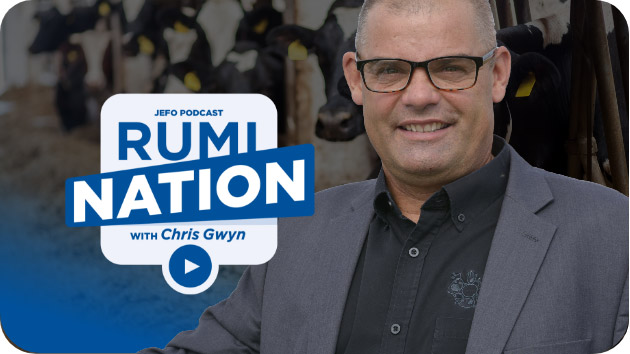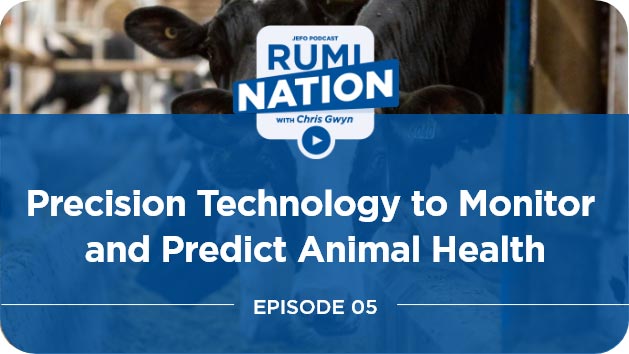RumiNation | S03 : E04
Impacts of Stressors on Physiology and Health of Dairy Cows
Brought to you by Jefo Nutrition
Share now!
Did you enjoy this episode?
Share now!
Our guest - Dr Trevor DeVries
Professor at the University of Guelph and Canada Research Chair in Dairy Cattle Behaviour and Welfare. His research projects include:
- Feeding behaviour of mature dairy cows
- Measures of behaviour to identify health status and future productivity
- Automated milking systems

Timestamps & Summary
2:04
What are some of the common stressors that cows may experience daily on a dairy farm?
Dr. Devries
The one that gets the most attention is probably heat stress.
But there are other stressors that cows may face regardless of environmental conditions throughout the year. The biggest one that we know is social stress. And that social stress can come from a variety of places.
Other kinds of stressors: Nutritional stressors. They are not only a stress on the cow physiologically, like a change in diet. Just from a perception standpoint, the cow may also view a big change in diet as a stressor.
Finally, just physiological events, like calving itself could be viewed as a stressor.
5:18
Could you expand a bit on how these stressors do affect the cow’s physiology?
Dr. Devries
For example, a stress that causes cortisol spike in cows may lead to a block or reduction in oxytocin release, which may limit milk let down in cows. Probably one of the clearest examples of that is bad handling of cows in the milking parlor.
We also know that many of these stressors are more chronic type stressors. If a cow has chronic stress, a physiological response to that would be an increased blood cortisol level, which can have negative impacts on the immune system and even reproductive hormones, leading to reproductive problems.
9:32
How do you successfully measure stress at the farm level?
Dr. Devries
Our biggest challenge is identifying through research known stressors and being able to walk on a farm and identify those stressors. From a prevention standpoint, or at least an identification standpoint, our easiest thing to do is probably just identify those known stressors and take care of those. We can also look to what the animals are doing.
To measure the behavior of the animals, we have lots of opportunities, different activity monitors, behavioral monitors, look for changes in activity, lying behavior, rumination, chewing, all those things could be indicative of stress. But the challenge there is that some of those are nonspecific.
12:18
How do we evaluate that at the farm level? What could be the impact of a single stress versus multiple stresses and do cows hit tipping points of stresses?
Dr. Devries
That’s a really good question and I’m not sure I have the exact answer. What we do in science is we isolate individual factors. In an ideal study, we control everything except the one factor that we’re really interested in studying so that we can isolate the effect of that. However, when we go out into the fields of commercial systems, we will often see examples of some of those stressors, but not necessarily see negative effects of those on some operations. Then, we’ll go to another operation where it’s obvious there is some negative effect going on.
So, the question becomes: is there an additive effect, or a compounding effect of some of these individual things? And I would say that that’s likely the case. But we just don’t have really good data today to support that.
18:41
What are the take-home points related to stressors and dairy cows you would like to leave to our audience?
Dr. Devries
Well, again, we know that stressors can negatively affect cows. And I think our challenge is identifying those that probably have the biggest impact on our farms and identifying how those might interact and compound. We can do that already, I think to some degree, but we would like data to be able to support some of these things. In the meantime, recognizing that stressors are there and looking at whether there are opportunities to minimize those on our farms and find solutions to those is where we’ve got to be moving within the industry.







